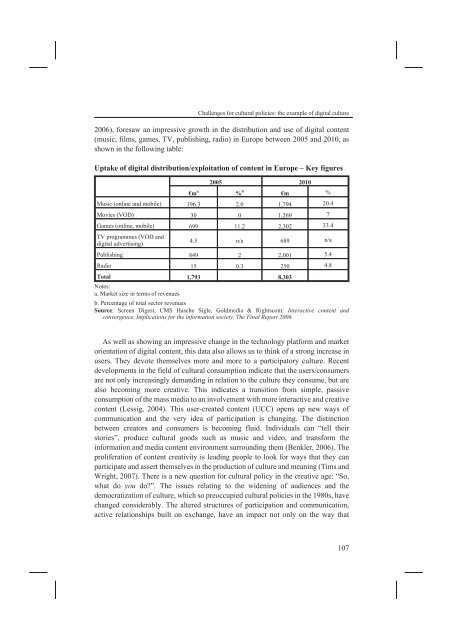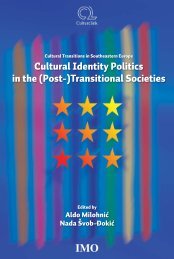D:\Documents and Settings\Ana\My Documents\Biserka-knjiga ...
D:\Documents and Settings\Ana\My Documents\Biserka-knjiga ...
D:\Documents and Settings\Ana\My Documents\Biserka-knjiga ...
Create successful ePaper yourself
Turn your PDF publications into a flip-book with our unique Google optimized e-Paper software.
2006), foresaw an impressive growth in the distribution <strong>and</strong> use of digital content<br />
(music, films, games, TV, publishing, radio) in Europe between 2005 <strong>and</strong> 2010, as<br />
shown in the following table:<br />
Uptake of digital distribution/exploitation of content in Europe – Key figures<br />
m a<br />
2005 2010<br />
Music (online <strong>and</strong> mobile) 196.3 2.0 1,794 20.4<br />
Movies (VOD) 30 0 1,269 7<br />
Games (online, mobile) 699 11.2 2,302 33.4<br />
TV programmes (VOD <strong>and</strong><br />
digital advertising)<br />
% b<br />
4.5 n/a 689 n/a<br />
Publishing 849 2 2,001 5.4<br />
Radio 15 0.3 250 4.8<br />
Total 1,793 8,303<br />
Notes:<br />
a. Market size in terms of revenues<br />
Challenges for cultural policies: the example of digital culture<br />
b. Percentage of total sector revenues<br />
Source: Screen Digest, CMS Hasche Sigle, Goldmedia & Rightscom: Interactive content <strong>and</strong><br />
convergence. Implications for the information society, The Final Report 2006.<br />
As well as showing an impressive change in the technology platform <strong>and</strong> market<br />
orientation of digital content, this data also allows us to think of a strong increase in<br />
users. They devote themselves more <strong>and</strong> more to a participatory culture. Recent<br />
developments in the field of cultural consumption indicate that the users/consumers<br />
are not only increasingly dem<strong>and</strong>ing in relation to the culture they consume, but are<br />
also becoming more creative. This indicates a transition from simple, passive<br />
consumption of the mass media to an involvement with more interactive <strong>and</strong> creative<br />
content (Lessig, 2004). This user-created content (UCC) opens up new ways of<br />
communication <strong>and</strong> the very idea of participation is changing. The distinction<br />
between creators <strong>and</strong> consumers is becoming fluid. Individuals can “tell their<br />
stories”, produce cultural goods such as music <strong>and</strong> video, <strong>and</strong> transform the<br />
information <strong>and</strong> media content environment surrounding them (Benkler, 2006). The<br />
proliferation of content creativity is leading people to look for ways that they can<br />
participate <strong>and</strong> assert themselves in the production of culture <strong>and</strong> meaning (Tims <strong>and</strong><br />
Wright, 2007). There is a new question for cultural policy in the creative age: “So,<br />
what do you do?”. The issues relating to the widening of audiences <strong>and</strong> the<br />
democratization of culture, which so preoccupied cultural policies in the 1980s, have<br />
changed considerably. The altered structures of participation <strong>and</strong> communication,<br />
active relationships built on exchange, have an impact not only on the way that<br />
m<br />
%<br />
107



